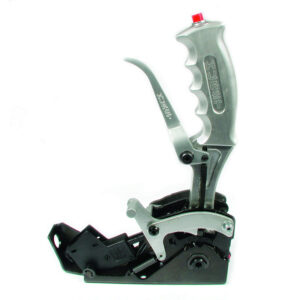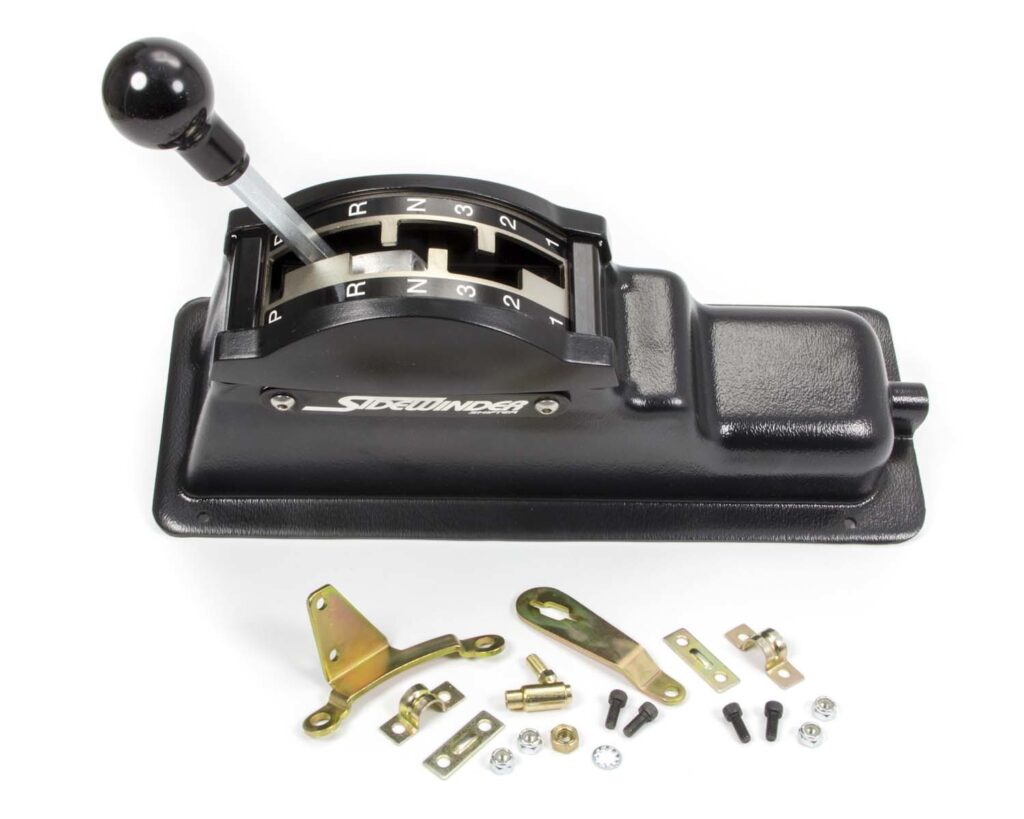While their purchase is often based on appearance rather than fit or function, automatic transmission shifters are frequently taken for granted. While there are a wide variety available throughout the automotive aftermarket, the chosen unit, whether if it’s for a race or street-driven machine, should not only be favorable to the user but more importantly, truly compatible with the given vehicle’s transmission.
While choosing between a gate or ratchet-type shifter may be a matter of personal preference, knowledgeable professionals recommend choosing a unit that is specific to the make of transmission. Even though universal, “one-size-fits-all” shifters may help manufacturers reduce SKU’s, which translates into a more cost-effective unit, their design, however, is truly compromised.
Due to the fact that GM, Ford, and Chrysler, for example, each utilize different detent increments between their shift patterns of their popular, early model automatic transmissions, shifter adjustment is compromised when working with a universal-style shifter. GM 2- (Powerglide) and 3-speed autos (TH-350/TH-400), for example, utilize a shift pattern that includes 1” of travel between park and reverse, while Ford C-4/C-6 transmissions have 3/4”, and Chrysler Torqueflite 904/727 automatics feature just 1/2”. Therefore, if a universal-fit shifter is adjusted properly with the transmission in “neutral”, it is often out of sync when placed in “park”.
As the shifter is moved through it’s range, the corresponding manual linkage inside the transmission “clicks” through the detents and the manual valve spools precisely through the valve body, subsequently blocking and opening hydraulic fluid channels, thereby allowing activation of the chosen gear. Paul Forte of Turbo Action states that when you choose an application-specific shifter and verify that it has been adjusted correctly, you are ensuring that the detents or gates in the shifter are precisely synced with the manual valve through the full range of gear selection from park through manual low. If the linkage isn’t adjusted properly, it can result in inconsistent or improper gear engagement. It can also create instances where it may be difficult to get the transmission fully into the “park” or “manual low” gear positions.
Forte additionally states that “it’s not only important that the shift pattern matches that of the transmission but that the corresponding shift lever (typically included with the shifter) is in place as well” to provide proper linkage geometry. He relates an instance at a drag race event where a hectic, in-between rounds transmission swap resulted in an on-track accident. Forte states that when the driver attempted to shift into neutral at the end of the run, he instead went into reverse, causing him to lose control and crash. It was later discovered that the racer had forgotten to install the correct shift lever during the hastily performed swap. Another important fact to be aware of is that since the pan bracket employed by many shifters attaches directly to the transmission pan rail, cast aluminum pans that feature extra-thick pan rails can be equally detrimental to linkage geometry. In that event, the pan should be machined or the bracket modified to correct the issue.
Fortunately, most high-quality shifters are application specific, such as the Hurst Quarter Stick, Turbo Action Cheetah, and Winters Sidewinder, each of which feature models designed exclusively for GM, Ford, or Chrysler. Each part number utilizes a detent pattern that precisely matches that of the respective transmission. Equally important is if the transmission in question is fitted with a reverse-pattern manual valve body (P-R-N-1-2-3), it’s important to confirm that the chosen shifter is compatible as well. Turbo Action and Winters offer gate plates separately to allow changing from a forward to a reverse pattern valve body or vice versa at a later date.


In the event that the shifter has been properly adjusted according to the manufacturer’s specifications and a problem persists, not only should the shifter be scrutinized but the linkage as well, as it may have been inadvertently damaged at some point during its life. Once a shifter has been selected, placement is an important consideration. It should be mounted in a position that allows the driver to easily select all of the gears, while remaining in a comfortable, seated position. This is especially important if the unit is fitted to a race car, ensuring that the driver can comfortably shift through the gears with restraints in place and cinched up tight.
When installing the shifter cable, it should always be routed in a manner that keeps it clear of the exhaust system. Although the cable is very durable, excessive heat can easily melt the outer covering, thereby damaging it. The Hurst Quarter Stick and Turbo Action Cheetah are offered with front or rear cable exits to provide eased cable routing. Another common cause of cable failure is insufficient chassis grounding. If a ground strap has been inadvertently left off during an engine swap, for example, the chassis can actually ground through the shifter cable, quickly damaging it.
The chosen shifter should always utilize a neutral safety switch, mandated by the NHRA and IHRA. When adjusted properly, the switch prevents starter activation when the shifter is placed in any gear other than neutral or park. Anybody that has spent a bit of time at the race track can probably attest to witnessing someone starting a car and seeing it instantly jerking forward or backward due to lack of or an improperly adjusted neutral safety switch.
Once a high-quality shifter has been chosen and properly installed, regardless of whether it’s fit to a full-fledged race car or a daily driver, it should provide reliable gear changes for many years to come.a